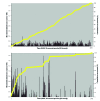A neuroanatomical basis for the frequency of discrete spontaneous activities in schizophrenia
- PMID: 19572020
- PMCID: PMC2703198
- DOI: 10.2174/1874440000903010048
A neuroanatomical basis for the frequency of discrete spontaneous activities in schizophrenia
Abstract
Limited behavioural repertoire impacts quality of life in chronic schizophrenia. We have previously shown that the amount of movement exhibited by patients with schizophrenia is positively correlated with the volume of left anterior cingulate cortex and that this quantity of movement can be increased by modafinil. However, increased movement in itself may be of limited clinical significance. Hence, we sought to analyse the 'structure' of spontaneous movement in patients with schizophrenia and to examine whether the chunking of spontaneous activity has a neuroanatomical basis. 'Actiwatches' were used to record spontaneous motor activity over a 20 hour period in sixteen male patients with schizophrenia. Time-series data were analysed for the number of discrete spontaneous activities, which might indicate a degree of structure to ongoing activity. Subjects underwent a whole-brain structural MRI scan. The 'number of discrete movement epochs' correlated with volumes of regions within bilateral rostro-ventral putamen and temporal poles. These data suggest that in people with schizophrenia the volume of bilateral putamen may influence the complexity of their behaviours, as distinct from the overall amount of behaviour. The results are presented in the context of a large body of previous research examining the role of the basal ganglia in motor and cognitive pattern generation.
Figures


Similar articles
-
Structural brain correlates of unconstrained motor activity in people with schizophrenia.Br J Psychiatry. 2005 Nov;187:481-2. doi: 10.1192/bjp.187.5.481. Br J Psychiatry. 2005. PMID: 16260826
-
Structural analysis of the basal ganglia in schizophrenia.Schizophr Res. 2007 Jan;89(1-3):59-71. doi: 10.1016/j.schres.2006.08.031. Epub 2006 Oct 30. Schizophr Res. 2007. PMID: 17071057 Free PMC article.
-
Resting state cerebral blood flow and objective motor activity reveal basal ganglia dysfunction in schizophrenia.Psychiatry Res. 2011 May 31;192(2):117-24. doi: 10.1016/j.pscychresns.2010.12.002. Epub 2011 Apr 20. Psychiatry Res. 2011. PMID: 21511443
-
Functional anatomy of thalamus and basal ganglia.Childs Nerv Syst. 2002 Aug;18(8):386-404. doi: 10.1007/s00381-002-0604-1. Epub 2002 Jul 26. Childs Nerv Syst. 2002. PMID: 12192499 Review.
-
Contributions of anterior cingulate cortex to behaviour.Brain. 1995 Feb;118 ( Pt 1):279-306. doi: 10.1093/brain/118.1.279. Brain. 1995. PMID: 7895011 Review.
Cited by
-
Enhanced persistency of resting and active periods of locomotor activity in schizophrenia.PLoS One. 2012;7(8):e43539. doi: 10.1371/journal.pone.0043539. Epub 2012 Aug 28. PLoS One. 2012. PMID: 22952701 Free PMC article.
References
-
- Andreasen NC. The Scale for the Assessment of Negative Symptoms (SANS) Iowa City IA The University of Iowa. 1983.
-
- Farrow TFD, Hunter MD, Wilkinson ID, Green RDJ, Spence SA. Structural brain correlates of unconstrained motor activity in people with schizophrenia. Br J Psychiatry. 2005;187:481–2. - PubMed
-
- Farrow TFD, Hunter MD, Haque R, Spence SA. A double-blind placebo-controlled cross over study of modafinil’s effect on unconstrained motor activity in people with schizophrenia. Br J Psychiatry. 2006;189:461–2. - PubMed
-
- Barnes TRE, Spence SA. Movement disorders associated with antipsychotic drugs: clinical and biological implications. In: Waddington JL, Deakin JFW, editors. Psychopharmacology of schizophrenia. London: Arnold; 2000. pp. 178–210.
-
- Haruno M, Kawato M. Different neural correlates of reward expectation and reward expectation error in the putamen and caudate nucleus during stimulus-action-reward association learning. J Neurophysiol. 2006;95:948–59. - PubMed
LinkOut - more resources
Full Text Sources
